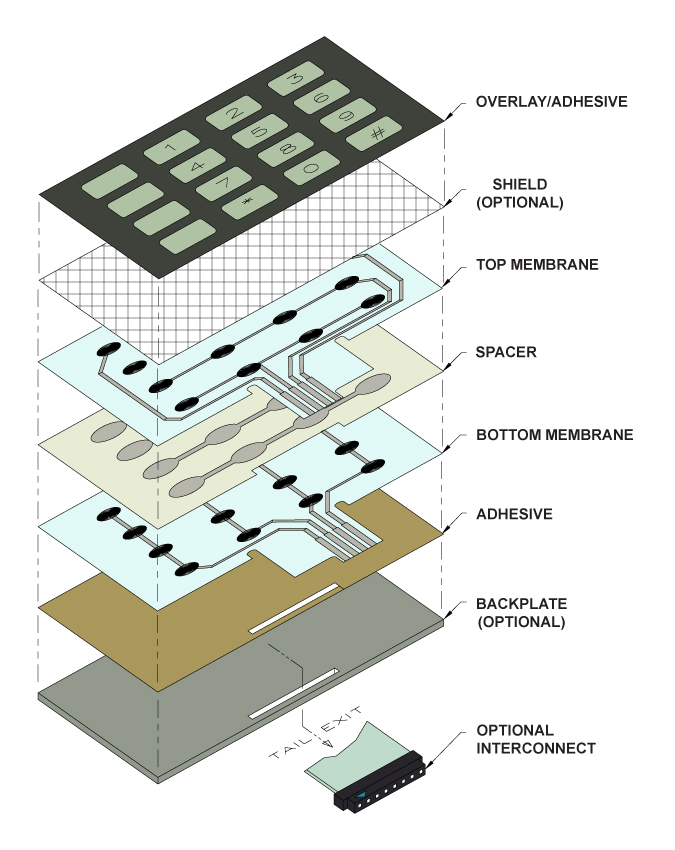Leading Advantages of Incorporating a Membrane Switch Into Your Digital Tools
Leading Advantages of Incorporating a Membrane Switch Into Your Digital Tools
Blog Article
Comprehending the Performance of Membrane Layer Switches Over for Interface Instruments
The performance of membrane switches over represents a significant innovation in interface design, incorporating efficiency with visual adaptability. These buttons operate through a multi-layered framework that equates user communications right into electric signals, enabling both small layouts and durability against ecological elements. As industries significantly focus on customer experience, comprehending the subtleties of membrane layer switch innovation ends up being vital. What implications do these improvements hold for future applications, and how might they redefine customer interactions across different devices?
What Are Membrane Layer Buttons?
Membrane layer buttons are cutting-edge user interface tools that help with individual interaction with digital tools. These flexible elements contain several layers, including a visuals overlay, spacer, and a printed circuit layer. The layout permits for a smooth integration into numerous electronic gadgets, enhancing both the visual and useful elements of individual interfaces.
Membrane switches are frequently employed in a wide array of applications, from household home appliances to industrial equipment and clinical gadgets. Their building and construction normally features a slim profile, making them a perfect selection for compact designs. The responsive responses supplied by these switches can be crafted to meet certain individual preferences, ensuring reliable communication between the customer and the tool.
Longevity is another significant benefit of membrane layer buttons, as they are resistant to dust, dampness, and chemicals, which improves their life expectancy in requiring environments. Furthermore, these buttons can be tailored in regards to shape, dimension, and visuals layout, enabling for branding and user-specific attributes. In general, membrane layer changes represent a practical option for improving user experience in electronic tools, combining performance with aesthetic allure in an effective fashion.
How Membrane Layer Switches Over Work
Operating on a straightforward concept, membrane layer switches over utilize a split construction to sign up user input efficiently. Each button includes multiple layers, including a published circuit layer, a spacer layer, and a leading graphic layer, which are made to interact flawlessly. When a customer presses the leading layer, it compresses the spacer layer, bringing the conductive aspects of the circuit layer into contact with each various other.
This call creates a closed circuit, signifying the device to carry out a certain function. The design enables for numerous arrangements, including tactile responses, which can boost the user experience by supplying a physical sensation upon activation. The products utilized in membrane layer buttons often consist of versatile substratums, such as polyester or polycarbonate, which make certain toughness and resilience versus wear and tear.

Key Advantages of Membrane Switches

One more considerable advantage is their density. Membrane switches are slim and light-weight, which allows makers to save area in their devices without giving up functionality. This attribute is particularly useful in applications where weight and quantity are essential considerations.
Additionally, membrane layer buttons are resistant to dirt, wetness, and chemicals, boosting their sturdiness. This resilience prolongs their lifespan and minimizes the need for constant substitutes, resulting in price financial savings over time.
Furthermore, the tactile feedback supplied by membrane layer buttons can be optimized to boost individual communication. They can consist of features such as increased switches or distinct clicks, boosting usability and individual experience.
Applications Across Industries
Interface devices using membrane switches are widespread in a broad variety of sectors, showcasing their adaptability and functionality. Membrane Switch. In the medical sector, membrane layer buttons are integral to gadgets such as diagnostic equipment and client surveillance systems, where their toughness and convenience of cleaning are essential for preserving health requirements. In the vehicle sector, these buttons are used in control panel controls and infotainment systems, offering a streamlined and modern-day user interface for customers.
Furthermore, the consumer electronic devices market advantages from membrane layer buttons in devices and portable tools, where portable layout and straightforward interfaces enhance customer experience. Industrial applications likewise take advantage of membrane changes for control panels in equipment and automation systems, stressing their effectiveness and resistance to severe atmospheres.
In the aerospace and defense markets, membrane layer switches are made use of in cabin controls and equipment, where reliability and efficiency under severe conditions are vital. Furthermore, the video gaming sector progressively integrates membrane switches in controllers and arcade equipments, adding to an engaging customer experience. Overall, the adaptability of membrane layer switches over allows their prevalent usage throughout numerous sectors, emphasizing their relevance in contemporary customer interface layout.
Future Fads in Membrane Switch Over Innovation

In addition, making use of advanced products, such as polycarbonate and polyester movies, is anticipated to increase, giving boosted longevity and resistance to ecological stressors. These materials add to the overall long life of membrane switches, making them appropriate for harsher commercial applications.
Furthermore, the consolidation of wise modern technology, including IoT connectivity, will make it possible for membrane layer buttons to communicate with other devices and systems, assisting in a much more interactive customer experience. This pattern aligns with the growing check out here demand for wise gadgets throughout various industries, from medical care to customer electronic devices.
Last but not least, customization official website options are anticipated to expand, permitting producers to produce bespoke options tailored to details user needs and preferences. These developments will certainly place membrane layer buttons as necessary parts in the development of individual interface technology.
Conclusion
To conclude, membrane switches over represent a crucial innovation in interface modern technology, using a reliable and functional service for diverse digital applications. Their split building promotes compact design, while features such as tactile responses improve user communication. The resilience versus environmental factors further solidifies their energy across several sectors. As developments in product scientific research and touch noticing technologies proceed, the functionality and applicability of membrane buttons are expected to expand, strengthening their significance in modern-day electronic gadgets.
Report this page